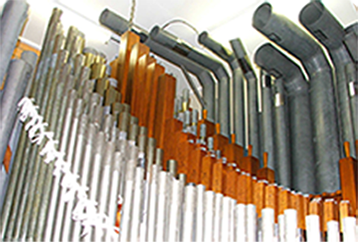Brook Arts Center
10 Hamilton Street, Bound Brook, NJ
Click here for a History of the Theatre
HISTORY OF THE ORGAN – A True Saga!
First Home 1928 – Pascack Theatre, Westwood, NJ
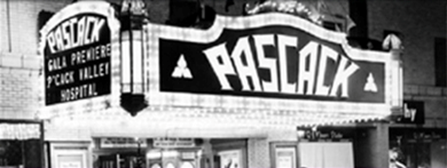 The Pascack 2/8 Wurlitzer theatre pipe organ, Opus # 1914 was installed in the newly built Pascack Theatre Westwood, NJ in 1928. The gala program on opening night August 19, 1928 featured William Boyd, Sue Carol and Alan Hale starring in “Skyscraper. A pipe organ concert was performed by Jessie Piercy, a well known organist in the area.
The Pascack 2/8 Wurlitzer theatre pipe organ, Opus # 1914 was installed in the newly built Pascack Theatre Westwood, NJ in 1928. The gala program on opening night August 19, 1928 featured William Boyd, Sue Carol and Alan Hale starring in “Skyscraper. A pipe organ concert was performed by Jessie Piercy, a well known organist in the area.
A short period of time followed when vaudeville and movies were offered to the public. Unfortunately, as time passed the organ music was discontinued, and the instrument fell into disrepair. Ranks of pipes were removed or destroyed. In 1973 a group of GSTOS members joined forces to restore the organ, Crew members were Warren Brown, Russ Fewell, Roy Frenzke, Richard Seigle, Dick Orr, Bob Quinn, Ed Unis, and Joe Vanore. It took 2 years before the organ was playable and to be able to be featured. The first intermission was celebrated July 4th 1976. The organist was GSTOS founder Jinny Vanore.
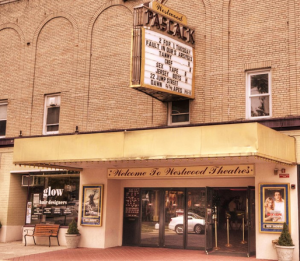 Since that debut, the Wurlitzer was played for Saturday night intermissions with many organists volunteering their talents. In 1980 the theatre was multiplexed. The solo chamber was moved and placed in a new pipe chamber on the stage to rejoin the console and the main chamber in the same room. The organ music played in Theatre #1 and was simultaneously piped into the other three theatres. Through the years United Artists Inc., the owners of the theatre and organ, were very cooperative. We were most fortunate to have Austin Gordon, who loved organ music, as manager of the venue. But by the 1990’s a change in United Artists’ policy was to only maintain large multi-screened theatres and they were selling their smaller ones. The Pascack Theatre fell into the small category and was sold. In December of 1996 the new owner donated the instrument to the Garden State Theatre Organ Society and asked us to remove it, since he was going to utilize the original stage area for two additional small theatres.
Since that debut, the Wurlitzer was played for Saturday night intermissions with many organists volunteering their talents. In 1980 the theatre was multiplexed. The solo chamber was moved and placed in a new pipe chamber on the stage to rejoin the console and the main chamber in the same room. The organ music played in Theatre #1 and was simultaneously piped into the other three theatres. Through the years United Artists Inc., the owners of the theatre and organ, were very cooperative. We were most fortunate to have Austin Gordon, who loved organ music, as manager of the venue. But by the 1990’s a change in United Artists’ policy was to only maintain large multi-screened theatres and they were selling their smaller ones. The Pascack Theatre fell into the small category and was sold. In December of 1996 the new owner donated the instrument to the Garden State Theatre Organ Society and asked us to remove it, since he was going to utilize the original stage area for two additional small theatres.
New Home 1997 – Brook Arts Center, Bound Brook, NJ
By this time the organ had little of the original Wurlitzer pipework remaining, having been refitted with mostly non-Wurlitzer pipes from various sources. Garden State found a new home for the instrument in the Brook Theatre, Bound Brook, N.J, a theatre of similar size and shape. The Brook is a 1312 seat 1926 vaudeville house that originally housed a Wurlitzer Style “B”, Opus # 1519. It was a 2/4 instrument in a single (house right) chamber installation. This original organ was removed around 1985.
GSTOS was asked to have the Pascack organ removed from the theatre by June 30, 1997. This left little time to plan and arrange not only the dismantling and removal from the chambers, but also the transportation to, and preparation of the new home at the Brook Theatre.
A dedicated group of GSTOS members worked for two weeks, often well into the night removing the tremendous number of parts, placing them on the stage, and packaging them. This at times required great physical strength, acrobatic balancing on ladders, and surviving in 90 degree temperatures.
On moving day, Saturday June 28, 1997, 15 members and helpers arrived and waited for the truck. While waiting for the truck, everyone lined all the parts, console, and relay on the sidewalk. It was quite a sight! The loading of the truck took over three hours. A caravan of the truck, followed by a packed van, cars with trailers, and cars with filled car racks drove to Bound Brook. The unloading was quicker and made easier with the help of four more members who waited at the Brook Theatre.
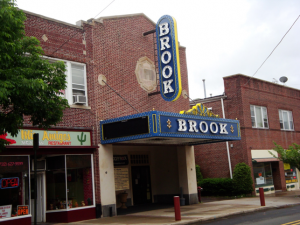 The crew rebuilt the entire Pascack organ and had started installing the solo chamber, when in September of 1999, with most of the organ stored onstage, Hurricane Floyd caused severe flooding in Bound Brook. The floodwaters filled the theatre to the depth of 13 feet, severely damaging most of the Wurlitzer, including the console, but leaving the chests and percussions already installed in the solo chamber intact.
The crew rebuilt the entire Pascack organ and had started installing the solo chamber, when in September of 1999, with most of the organ stored onstage, Hurricane Floyd caused severe flooding in Bound Brook. The floodwaters filled the theatre to the depth of 13 feet, severely damaging most of the Wurlitzer, including the console, but leaving the chests and percussions already installed in the solo chamber intact.
Two organs were donated to help restart the project. Jim Breslin donated a 2/8 Mōller, and Joe and Ginny Martin donated a 2/7 single chamber Wurlitzer, style 175. The pipe work from the Martin instrument is almost identical to that of the original Pascack Wurlitzer specification except for the lack of a clarinet. Since little remained of the original instrument, the crew decided to re-specify the organ and enlarge it. A three-manual console was purchased to replace the destroyed 2 manual Pascack Wurlitzer keydesk.
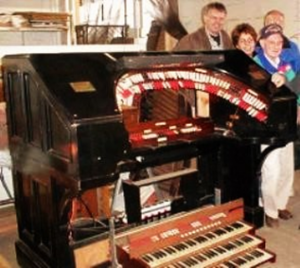
Babson Wurlitzer Console
This Style 235 console was part of a 3/13 Wurlitzer Opus 1349 that was installed in the Loew’s State Theatre in Boston, Massachusetts on May 28, 1926. The 4000 seat Thomas W. Lamb theatre was closed August 1959 and was demolished in 1968. Fortunately the whole organ was saved by The Eastern Massachusetts Chapter of ATOS and installed in Knight Auditorium at Babson College in Wellesley, MA. The console remained playing in Knight Auditorium until around 1996 at which time it was replaced with a new 4 manual console. The console then went to a private owner until GSTOS purchased and moved it to Bound Brook in the fall of 2004.
The new Brook organ plan calls for additional ranks to make a 3/11 instrument with room for expansion to 15 or more ranks.
The main chamber will house five original Wurlitzer ranks: Concert Flute, Open Diapason, Viole, Viole Celeste, and Clarinet. A Tuba horn and an additional string will bring the chamber to seven ranks. The solo chamber houses a Wurlitzer Tibia, Style D Trumpet, and Vox. A five-horsepower Spencer blower powers the main chamber and a three-horsepower Spencer powers the solo chamber. The organ is controlled by an Artisan electronic relay to provide flexibility and reliability in operation.
Since GSTOS started this project, the Brook Theatre was purchased by a non-profit organization and turned into the Brook Arts Center. Over three million dollars of federal, state and county funding was provided to purchase and rehabilitate the damaged theatre with new electric service, plumbing, heating and air conditioning. New comfortable seating was installed and the theatre reopened seven years after the Hurricane Floyd flood in the fall of 2006.
Brook Arts Center Flooded AGAIN For the Second Time in 6 Years!
Several months later, in May of 2007, the Raritan River again flooded downtown Bound Brook following excessive rain that caused muddy waters to fill the theatre to about 18 inches above the stage height. Incomplete flood control projects were unable to protect the area. As a result, the “new” Babson console and both blowers were under water. In addition, the adjoining work shop was flooded and some organ parts and assorted equipment were also flooded. In anticipation of the storm, much of the valuable and irreplaceable equipment was moved to the second floor. The 10 ranks of pipes that at this point had been installed in their chests located above stage right and left were secure.
Organ Rescue: Despite the short notice, late Sunday night, Tony & Carole Rustako, and Denise & George Andersen rushed to the theatre to protect the organ as much as possible. They worked until they were chased away at 2:00 AM by the rising waters and the evacuation of the downtown area. In that time they managed to move most of the tools, the leather supplies, important pipework, chests, regulators and tremulants to the second floor of the warehouse or onto high shelves on the first floor. The good news is that ten ranks were safe and sound in their chests in the organ chambers. The blowers were under water and will have to be serviced. The Babson console, still in the orchestra pit, was damaged by the water. Luckily the console had only temporary keyboards and a temporary stop rail. The electronics are probably fine, since the organ wasn’t powered during the flood. The pipework from the Pascack Theatre, still surviving from the 1999 flood, was under water and needs to be cleaned yet again. We did lose some minor tools and spare parts, but we didn’t lose anything irreplaceable other than the console. Our frustration was that the crew had been playing, troubleshooting, and tuning the organ for the previous two weeks, preparing it for the GSTOS meeting that was scheduled at the theatre on April 29, 2007. When it was played the Thursday before the flood, the organ sounded fantastic. The large live auditorium at the Brook is a perfect match for the Wurlitzer’s sound.
Future of the Brook
One big question was the fate of the Brook venue itself. The new seats were fully submerged and will have to be replaced. The new electrical distribution panels will have to be replaced. The new hot water furnaces need cleaning and the environmental control electronics will also have to be replaced. There was no serious structural damage, but some interior walls in the stage basement and the walls around the blower rooms will have to be replaced. The water never reached the inner lobby and the outer lobby is mostly brick and concrete, so it suffered little damage. The Brook Arts Center has flood insurance that should be sufficient to repair and reopen the theatre. Any work on the theatre requires the approval of both US Economic Development Administration and the New Jersey Economic Development Authority. The Brook Board is seeking that approval. All indications are that the Brook Theatre will open once again since local and government support for the Arts Center are strong.
Rodgers Marquee Electronic Organ Donation
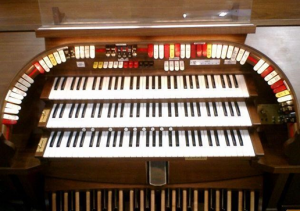
Rodgers Marquee 327 Electronic Theatre Organ
Long time GSTOS member Ed Baykowski had been a friend of Mr. and Mrs. Lloyd Christensen of Rumson, N.J., and was contacted by their sons after Mr. Christensen’s passing in December, 2006. The family was seeking to donate their Rodgers organ to a worthy organization. Many years ago the Christensens along with Mr. and Mrs. Leonard Lipman (who were GSTOS members) attended Trenton War Memorial concerts regularly. Ed Baykowski was invited to their home and had the opportunity to play the organ there. Ed put the family in contact with GSTOS Vice President, Michael Cipolletti. Along with Tony Rustako, they visited the home and found the organ to be nicely playable after a quick bit of fixing. The Christensen family chose to donate the organ to our organization after learning that part of our charter is to provide education and that the organ could be used for that purpose. In true GSTOS fashion, Tony and Carole Rustako, Hans Muhler, and Michael Cipolletti loaded the organ and accessories into George Christensen’s truck and drove it to be stored in the Brook Arts Center Theatre in Bound Brook.
The organ is a Rodgers 327 Marquee, a three manual console with two speaker cabinets, a live glockenspiel, and a complete set of electronic action Deagan chimes. It presents a good electronic example of how a theatre pipe organ sounds.
Brook Reopens –AGAIN!
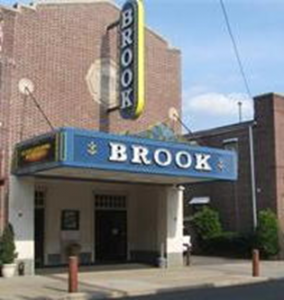 On Friday, September 18, 2009, over two years after the second flood, the Brook Arts Center was back in business. For the first time since the unnamed storm that flooded the building a second time, the Brook opened its doors for patrons. The production was sponsored by GSTOS and featured Bernie Anderson at the GSTOS Rodgers Marquee electronic organ as he accompanied the silent movie, “The Winning of Barbara Worth”. Bernie played with compassion and remarkable timing which brought the film to life. There were 125 patrons and the proceeds were donated to the Brook. In the welcoming remarks, GSTOS President, Michael Cipolletti told the audience that we have been the first resident company in the Arts Center and that we have not faltered in 13 years despite adversities. The Wurlitzer pipe organ lost its new console to the second storm three days after the organ played for the first time for the crew members.
On Friday, September 18, 2009, over two years after the second flood, the Brook Arts Center was back in business. For the first time since the unnamed storm that flooded the building a second time, the Brook opened its doors for patrons. The production was sponsored by GSTOS and featured Bernie Anderson at the GSTOS Rodgers Marquee electronic organ as he accompanied the silent movie, “The Winning of Barbara Worth”. Bernie played with compassion and remarkable timing which brought the film to life. There were 125 patrons and the proceeds were donated to the Brook. In the welcoming remarks, GSTOS President, Michael Cipolletti told the audience that we have been the first resident company in the Arts Center and that we have not faltered in 13 years despite adversities. The Wurlitzer pipe organ lost its new console to the second storm three days after the organ played for the first time for the crew members.
Brook Crew Acquires ANOTHER “New” Console
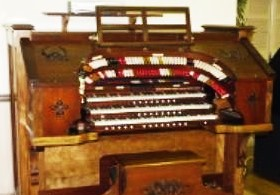
Restored 1927 Organ Supply Industries Console
Shown at the Rahway Senior Citizens Center
May, 2010: Our GSTOS organ crews can’t get enough fun from working on just our existing instruments, so we have recently purchased a three manual console that is equipped to play 18 ranks, and is already wired for use with a new solid state/computer relay. Richard Lewis, organist and technician, sold us this completely restored 1927 Organ Supply Industries 3 manual 2 bolster theatre organ console, refinished in natural mahogany with matching dogleg style bench, because he decided to upgrade to a four manual keydesk. It’s updated electronics will allow it to play either the Rainbow Room or the Brook chests and pipework. Thanks to the foresight and skill of our crack technicians, Cal Bacon, George Andersen, Mike Fox, and Tony Rustako, the two organs will have interchangeable parts. At this time, the newly acquired console has been temporarily moved to the Rahway Seniors Center where it soon will play the Rainbow Room Wurlitzer until the rebuilding of that instrument’s original art deco style console is completed. Then, in a game of console musical chairs, it will be transported to the (hopefully dry) Brook where it will control the Wurlitzer that is ready-to-go but awaiting a console rebuild after the second flood’s damage. This acquisition will enable us to move ahead more quickly with our installation projects. The console was purchased for $2,500. Long time member Ed Baykowski volunteered to underwrite the cost of this purchase through a donation to GSTOS in memory of his parents. He will be able to see his generosity in action whenever the console plays!
Crew Report – Brook Wurlitzer
August, 2010: Having regained access to the building following the second flood, the crew has started work sessions at the Brook Theatre again. Work had stopped on the Brook Wurlitzer while the crew shifted focus to work on the Rainbow Room organ in Rahway. During recent visits to the theatre, we have surveyed the condition of the Wurlitzer and mapped out a plan for the completion of the organ. The chambers are exactly as we left them, except for a bit of dust. There are nine ranks that have been installed and are about to play with some tweaking. The warehouse was “moistened” to a depth of about five inches this past March, so the floor is covered with a thin film of dirt. Anything important had been lifted above the floor, so there was no damage to our tools or stored organ parts that we could see. The theatre itself stayed dry during the storm except for some water in the basements. The auditorium looks great, with five hundred seats in place for the audience. The aisles have been carpeted, the auditorium painted, and the theatre is in excellent condition with more improvements coming soon. The Brook has been presenting several shows each week, so they are building an audience. The theatre front is being revitalized and looks great. The marquee is being rebuilt and you can expect an unveiling in September. Brook management hopes the Wurlitzer will play for the unveiling, and we will try to accommodate them.
Early this spring, GSTOS purchased a three-manual console from organist Richard Lewis, funded by a generous donation from long time member Ed Baykowski. This console is being rewired and checked at the Rahway Srs Center. We purchased it because it is a working console complete with stop actions, good keyboards and a combination action, It is compatible with both the electronic relays at the Brook and Rahway Rainbow. The console needed only a little work to get it playing. That work is nearly complete, and it is being used to play the Rainbow Room organ chambers. The Lewis console will be used at Rahway until the art deco style Rainbow Room console is completed. Then it will move to the Brook. It will NOT be placed in the orchestra pit until the Greenbrook flood control project is completed early next year. We are negotiating with theatre management to install a lift on the stage to store the console seven feet above the stage, out of floodwater range, when it is not in use. Once the flood control project is complete, we will install a lift in the pit to place the console in the traditional position during performances, and then move it above the stage when it is not in use. At the Brook, the crew originally installed the Artisan Legacy Organ Control System, (an electronic relay) which has since been superseded by the Artisan MicroMIDI system. The majority of the circuit boards and wiring are identical in both systems. Artisan was willing to replace all of the Legacy processors with the newer MicroMIDI processors at no cost to GSTOS. That represents several thousand dollars in upgrades. It will take Cal Bacon and George Andersen a few weeks to put the new boards in place. R&R Stairs has rebuilt our “Babson” console, damaged by the second flood, and it looks great. The console does not have any stop tabs, so we will have to make a decision on its disposition. It needs to be refinished and it needs Syndyne stop actions and tabs. The manuals also need to be rebuilt. R&R made some changes in the rebuild so it can now accommodate four manuals and is quite beautiful. The crew is evaluating the ranks and chests stored in the Brook warehouse. The useable chests and ranks will be moved to another storage facility and the remainder will be sold or discarded. The Rodgers Marquis electronic organ is safely stored at the back of the auditorium at the Brook, and can be easily moved to the front of the auditorium for use. The crew is upgrading the Rodgers to MIDI for use with the Wurlitzer chambers or with a Miditzer type system. The original Rodgers tone generators are unmodified and can still be used.
Cloud Lifts from Bound Brook Wurlitzer – It Plays!
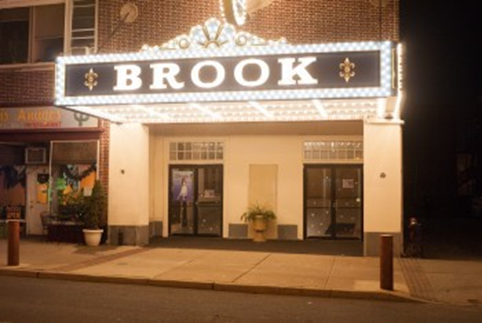 June, 2011: After 15 years, the sun shone on the Brook Arts Center right through to the Wurlitzer organ that has suffered hurricanes, floods, and changes of theatre management, threatening the installation’s chances of ever playing in the building. At the general membership meeting on June 5, 2011, GSTOS members were treated to the incomplete, but still very listenable sound of the instrument. We now have a good idea of what the final sound quality of the organ and the theatre will become. At this time the organ is being controlled by the Rodgers Marquee console. It is now able to play the original Rodgers electronic circuitry, and also the Wurlitzer pipe organ – simultaneously, if desired. Presently, 10 ranks of pipes are playable and are under expression of the working swell shades.
June, 2011: After 15 years, the sun shone on the Brook Arts Center right through to the Wurlitzer organ that has suffered hurricanes, floods, and changes of theatre management, threatening the installation’s chances of ever playing in the building. At the general membership meeting on June 5, 2011, GSTOS members were treated to the incomplete, but still very listenable sound of the instrument. We now have a good idea of what the final sound quality of the organ and the theatre will become. At this time the organ is being controlled by the Rodgers Marquee console. It is now able to play the original Rodgers electronic circuitry, and also the Wurlitzer pipe organ – simultaneously, if desired. Presently, 10 ranks of pipes are playable and are under expression of the working swell shades.
The history of this organ includes a combination of the Pascack (Westwood) Wurlitzer and the Joe and Ginny Martin Wurlitzer that were brought together to form one working instrument. Other sets of pipes were obtained to form a comprehensive organ whose ranks had been, in part, specified by famed organist Ashley Miller. Crew members toiled over the years and brought the instrument back twice from flood waters. The project was stalled several times as we were locked out because of the building being shut down and without heat or electricity. As with any piece of equipment, lack of use and temperature extremes set the crew back causing restoration to be ‘done-over’.
Sane people would have walked away on any of numerous occasions and considered it a loss.
But GSTOS crew members, up to 25 at one time, have never been thwarted by disaster, and instead became more determined to fight the odds. The crew has the technical expertise of our electronics wizards, George Andersen, Cal Bacon, and Tony Rustako, who designed a relay that could be controlled from the Rodgers Marquee console and will eventually play from the three manual Baykowski donated Organ Supply Industries console that temporarily controls the Rainbow Room pipework at the Seniors Center in Rahway. When the Rainbow art deco style console is completely rebuilt, the Organ Supply console will then be moved from Rahway to Bound Brook, allowing the Brook organ to become more versatile. In the last week before our June meeting, crew members Glynn Gillette, Jack Springer, Denise and George Andersen, and Michael Fox, with help from Henry Romanczyk, became excited at the prospect that the organ could play sufficiently well to entertain the members at our meeting. Glynn, Mike and George stayed well into the night three times fighting the clock to have this much of the organ playable. Their work was nothing short of heroic!
In its current configuration, the Brook organ has a seven rank chest in the Main Chamber with the following 6 ranks: Concert Flute, Open Diapason, String, String Celeste, Clarinet, and French Horn. The crew had a Kinura, for the 7th rank, but it would usually be located in the Solo Chamber and it sounded out of place, so it was moved into storage pending the location of a more appropriate rank for the Main. Also in the Main Chamber is an Austin Vox-in-a-Box (stand alone) and the Chrysoglott. Provisions have been made for another additional rank in the Main, probably a flue rank. The Solo Chamber has the following ranks: Tibia, Style D Trumpet, and Vox Humana. This brings the total number of currently functioning ranks to 10. The Solo Chamber also houses a Glockenspiel, Xylophone, Chimes and the Toy Counter. There is room for additional chests in the Solo Chamber. The crew will now concentrate on making sure that every note plays properly and that the console controls every rank. There are several ciphers and dead notes that still have to be addressed. Once the current rank count is playing perfectly, they will proceed with tonal finishing, and then add additional ranks if they find it necessary for the overall balance of the instrument. There is a flute triangulaire (a three sided flute pipe) that was a gift from Ashley Miller. He liked the sound and wanted it added to the organ. It is ready to be installed except the triangular shape of the pipes cause them to bump against each other when placed in the chest. Thus: “a triangular pipe in a round hole” A different chest needs to be obtained.
Meantime we can celebrate the fact that another theatre pipe organ is breathing life and music. We are to be reminded that our core of dedicated GSTOS rebuilders has added another credit to their reputation.
Brook Update
September, 2011: The Brook Arts Center has been heading in a very positive direction with more performances and events held at the theatre. Revenues have increased. Local and county political and financial support have been extremely positive and growing. The Brook Board is investing in upgrades to the building and facilities and improved maintenance.
The Wurlitzer organ crew has again been working diligently since the GSTOS meeting at the Brook in June. Denise Andersen, Tony Rustako and Michael Cipolletti have been working on cleaning up minor issues like dead notes and ciphers. These problems are partly due to dust and debris that have settled on the organ during the construction at the theatre over the last few years. Cal Bacon, Denise Andersen, Glynn Gilette and George Andersen have been working on adding additional capabilities to the organ, cleaning up wiring issues, improving the appearance of the chambers and making sure that the organ control system is reliable and easy to use. The sostenuto switch and improved couplers should be working in the next few weeks. The Rodgers Marquee console is working well with the chambers, and it now gives us the ability to play the pipes in both chambers in a capable fashion. The Rainbow Room Wurlitzer art deco console is nearing completion, and thus we should be able to move the Organ Supply Industries console, donated by Ed Baykowski, from Rahway to the Brook this fall. The conversion from the Rodgers to the Organ Supply Industries console should be painless since the new console has proved to be very reliable in Rahway and the Brook chambers are making great strides in reliability. The most important fact is that the Brook management is very positive in its attitude toward GSTOS and the Wurlitzer. They eagerly anticipate the presentation of the Wurlitzer for public performances.
Continuing Updates
October, 2011:
The crew is looking forward to the first public presentation of the GSTOS 3/10 Wurlitzer on Halloween at the Brook Arts Center. The organ was played for GSTOS members at the June business meeting, and it just keeps getting better. Despite record river levels and some flooding on Main Street in Bound Brook during the recent storms, the flood control system kept the Brook Theatre and the GSTOS Wurlitzer high and dry. We have modified the Rodgers Marquee console so that it can be used either as the original electronic organ, or to control the pipes. For this performance, of course, we will be using the pipes. The main chamber houses a Concert Flute, Open Diapason, String, String Celeste, Clarinet, French Horn, Vox-in-a-box and Chrysoglott. The solo chamber houses the Tibia, Vox and Trumpet plus the Xylophone, Glock, and Toy Counter. All ranks are Wurlitzer except for the French Horn and the Austin Vox-in-a-box. The crew is currently checking over the entire instrument and will be tuning and doing minor repairs over the next few weeks. On October 31, 2011 at 8 PM. Bernie Anderson, Jr. dazzeled the audience with his masterful accompaniment of the 1925 silent film “Phantom of the Opera” starring Lon Chaney.
October, 2012:
Bernie Anderson again played the organ in a shakedown mode for the public at “Weekend Journey Through the Past” a Somerset County Cultural and Heritage Initiative. He accompanied four silent short films, and later presented “Nosferatu” for the Halloween show. All these performances utilized the Rodgers Marquee console to control the pipes. Now that the Rainbow Room Art Deco console is in use, the Organ Supply Industries console is in storage at the Rahway Seniors center awaiting rewiring to match the Brook pipework.
October, 2013: Bernie Anderson will present “Phantom of the Opera” for the Halloween program, another shakedown performance.
December, 2014:
Young organist Andrew Van Varick presented a concert at the organ utilizing the Rodgers Marquee console for the GSTOS Holiday Party.
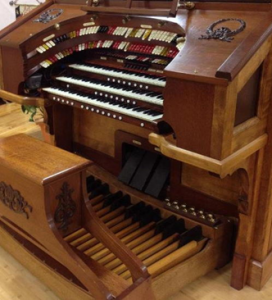
The Organ Supply Console Plays the Instrument!
August, 2015:
Young organist Luke Staisiunas debuted the instrument with the completed Organ Supply Industries console at a miniconcert for GSTOS members.
December, 2015:
Organist Nathan Avakian played a miniconcert for the GSTOS Holiday Party.
September, 2016: We anxiously await tonal finishing and a grand concert debut for the storied Brook Wurlitzer.
Notes: The original flood damaged 2 manual console from the Pascack Theatre was acquired by Nelson Page to be restored as a second console for the Lafayette Theatre Wurlitzer, Suffern, N.Y. Never restored, it is believed to still be at the Lafayette. The Babson Console was partially restored by a local woodworker. It is has now gone to the Central Florida Chapter of ATOS.






